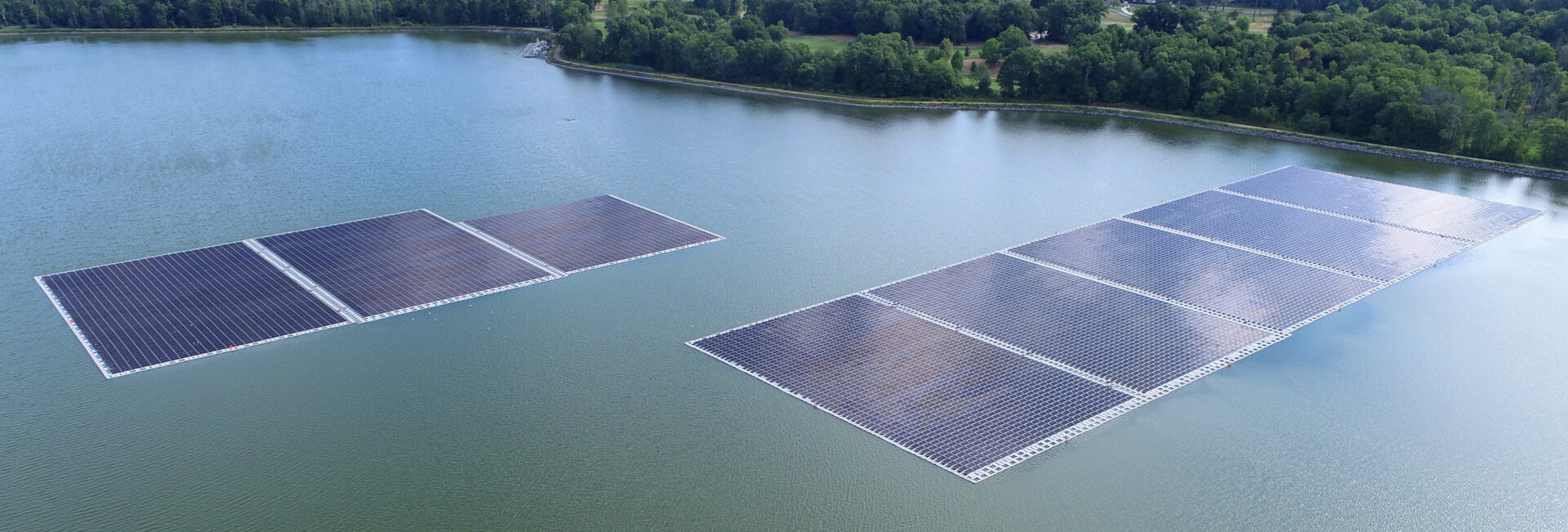
Reduced Algae Growth
Shielding of the water by the floating solar island helps to decrease the maintenance costs of cleaning pipes.
Increased PV Production
Result from cooling provided by water.
Floating solar power generating systems typically generate more electricity than ground-mount and rooftop systems due to the cooling effect of the water on the panels and cables. The water keeps ambient temperatures around the solar panels lower, which helps boost their efficiency and limits long-term heat-induced degradation.
Panels decreasing efficiency curve depends on temperature: ground mounted solar panels technology presents up to 10% efficiency loss due to extreme high sunlight exposure especially in summer when we expect the most energy produced.
Floating array can be 10% more productive than land-based systems.
Eco-friendly
Shading effect contributes to the aquatic ecosystem.
Prevents Water Evaporation
Shading provided by the solar panels.
According to Yale's School of Forestry and Environmental Studies, “major lakes in the southwestern US like Lake Mead and Lake Powell can lose more than 800,000 acre-feet of water to evaporation per year, and "floatovoltaics" could prevent up to 90 percent of that evaporation.”
No Effect on Water Quality
Low Environmental Impact
No excavation work - projects can be built without traditional solar ground mount site preparation such as pile driving, fence and road construction.
Limits Erosion
By reducing wave action.
Avoids Competition for Land Use
Utilizes unused water surfaces for energy generation.

Creates Hybrid System
Solar power is generated during the day while the reservoir stores up water and energy for release during peak demand periods.
Increased Hydropower Output
Preserves water so that more water can be used for electricity generation.
Complementary Generation
Solar power variation is smoothed by hydropower generation.
The hydropower plant reduces its output when solar output is high, and increases hydropower output when solar output is low. This complementary operation allows increases in total energy generation and improvement in the reliability of power output enabling combined output to meet the grid power dispatch curve.
Virtual Battery
Ability of the hydropower plant to act as a virtual battery of the floating solar PV plant.
Under a “virtual battery” configuration, during high irradiation time, the power generated by the floating solar panels is transmitted to the grid and used directly, while either the reservoir accumulates (when there is an inflow stream) or just holds water that can be later used during times of low or absent solar irradiation. In this manner, the reservoir itself becomes a battery, where the “charge” is the water spared from being used or accumulates while the direct solar energy is being used.
Saves on Additional Infrastructure Costs
Takes advantage of existing transmission infrastructure, such as transformers and interconnection to the power grid.
Pumped Storage Floating Solar PV Plants Benefits
The power system as a whole gains efficiency from reducing the need for spinning reserves while generating power from the floating solar system.
Reduced Algae Growth
Shielding of the water by the floating solar island helps to decrease the maintenance costs of cleaning pipes.
Increased PV Production
Result from cooling provided by water.
Floating solar power generating systems typically generate more electricity than ground-mount and rooftop systems due to the cooling effect of the water on the panels and cables. The water keeps ambient temperatures around the solar panels lower, which helps boost their efficiency and limits long-term heat-induced degradation.
Panels decreasing efficiency curve depends on temperature: ground mounted solar panels technology presents up to 10% efficiency loss due to extreme high sunlight exposure especially in summer when we expect the most energy produced.
Floating array can be 10% more productive than land-based systems.
Eco-friendly
Shading effect contributes to the aquatic ecosystem.
Prevents Water Evaporation
Shading provided by the solar panels.
According to Yale's School of Forestry and Environmental Studies, “major lakes in the southwestern US like Lake Mead and Lake Powell can lose more than 800,000 acre-feet of water to evaporation per year, and "floatovoltaics" could prevent up to 90 percent of that evaporation.”
No Effect on Water Quality
Low Environmental Impact
No excavation work - projects can be built without traditional solar ground mount site preparation such as pile driving, fence and road construction.
Limits Erosion
By reducing wave action.
Avoids Competition for Land Use
Utilizes unused water surfaces for energy generation.

Creates Hybrid System
Solar power is generated during the day while the reservoir stores up water and energy for release during peak demand periods.
Increased Hydropower Output
Preserves water so that more water can be used for electricity generation.
Complementary Generation
Solar power variation is smoothed by hydropower generation.
The hydropower plant reduces its output when solar output is high, and increases hydropower output when solar output is low. This complementary operation allows increases in total energy generation and improvement in the reliability of power output enabling combined output to meet the grid power dispatch curve.
Virtual Battery
Ability of the hydropower plant to act as a virtual battery of the floating solar PV plant.
Under a “virtual battery” configuration, during high irradiation time, the power generated by the floating solar panels is transmitted to the grid and used directly, while either the reservoir accumulates (when there is an inflow stream) or just holds water that can be later used during times of low or absent solar irradiation. In this manner, the reservoir itself becomes a battery, where the “charge” is the water spared from being used or accumulates while the direct solar energy is being used.
Saves on Additional Infrastructure Costs
Takes advantage of existing transmission infrastructure, such as transformers and interconnection to the power grid.
Pumped Storage Floating Solar PV Plants Benefits
The power system as a whole gains efficiency from reducing the need for spinning reserves while generating power from the floating solar system.
